Last Updated on February 8, 2024 by teamobn
Barbecuing is simple. Cooking meat over fire is a tradition that’s found in every culture and it’s almost as old as humanity itself. The custom began when Homo erectus – a human ancestor – learned to cook meat with fire 1.8 million years ago. Finding a safe way to connect a propane tank to your gas grill is today’s challenge.
Gas grills are a convenient and quick alternative to charcoal grills. You might take close to half an hour to start a barbecue with charcoal. With a gas grill, it often takes no time at all.
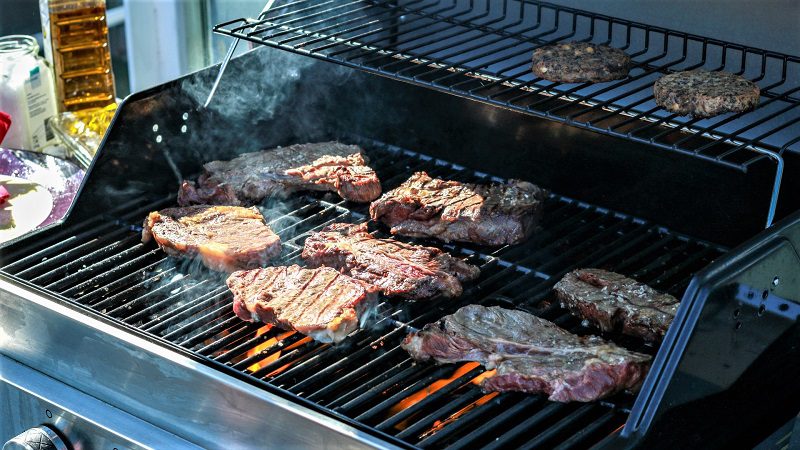
Contents
- 1 How to Connect a Propane Tank to Your Gas Grill
- 1.1 1. Make sure the propane tank isn’t damaged.
- 1.2 2. Check if the tank contains enough gas.
- 1.3 3. Make sure the propane tank is properly positioned.
- 1.4 4. Connect the tank to the grill.
- 1.5 5. Perform a gas leak test before lighting the grill.
- 1.6 6. Be sure to close the propane tank valve when you’re done cooking.
- 2 Troubleshooting Common Issues
- 3 FAQ to Connect a Propane Tank to Your Gas Grill
- 3.1 How do I know when to replace my propane tank when I connect it to my gas grill?
- 3.2 Can I connect a propane tank to my gas grill in any weather?
- 3.3 Is it safe to connect a propane tank to a gas grill alone?
- 3.4 What should I do if I smell gas after I connect a propane tank to my gas grill?
- 3.5 How tight should the connection be when I connect a propane tank to my gas grill?
- 3.6 Can I use any size propane tank to connect to my gas grill?
- 3.7 How often should I perform a leak test when I connect a propane tank to my gas grill?
- 3.8 What should I do with my old propane tank when I connect a new one to my gas grill?
- 4 Conclusion
How to Connect a Propane Tank to Your Gas Grill
Most modern gas grills run on propane tanks. One tank can last a whole summer if you only grill on weekends. Installing a propane tank on a gas grill — or in a propane smoker — is easy, simple, and quick.
However, you first need to know the safety considerations involved. Besides preventing dangerous accidents, certain safety procedures protect your grill against damage and misuse.
1. Make sure the propane tank isn’t damaged.
The first step is to connect a propane tank to your gas grill is make sure the propane tank isn’t damaged. You don’t have to worry as much about this if you happen to be using a new tank. But it’s still safer to do a quick inspection.
Many people use the same tank for years on end, simply connect a propane tank to your gas grill once it’s empty. In the United States, a tank is qualified for 12 years from the date of manufacture. In Australia, LP tanks require testing every ten years.
If you connect a propane tank to your gas grill, it’s essential to check that it is still in good condition regularly. Filling a damaged or out-of-date gas bottle is illegal and can be dangerous.
Propane tanks come with a valve to control the flow of the gas. You’ll find a rubber gasket housed inside the coupling mechanism of the hose. Make sure the gasket has no cracks or splits when you connect a propane tank to your gas grill. The gasket can get worn over time.
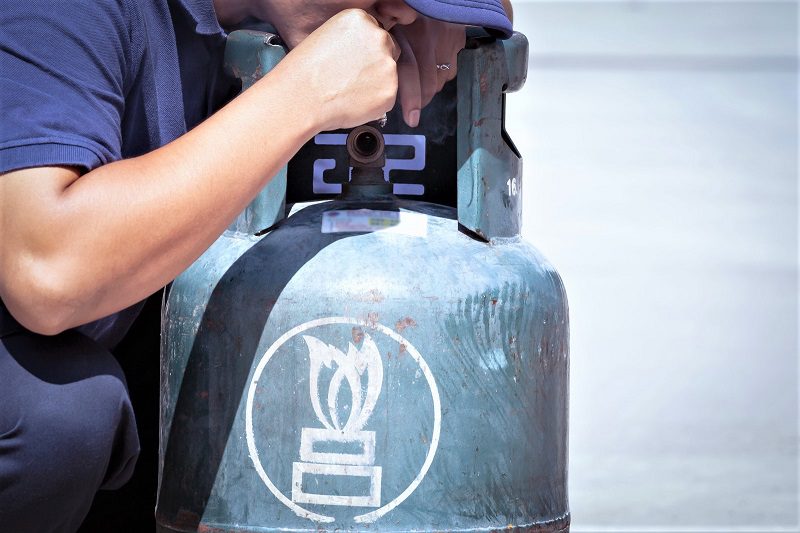
2. Check if the tank contains enough gas.
Before you connect a propane tank to your gas grill check that it contains enough gas. The easiest and most accurate way to check the amount of propane inside a tank is with a pressure gauge.
Propane tank gauges come in several different forms. If you don’t already have a gauge, head to the closest hardware store or go online to buy one.
We favor simple pressure gauges that connect directly to the valve. There are also magnetic gauges that work by detecting the temperature of the propane. However, these types of gauges often malfunction and do not last long.
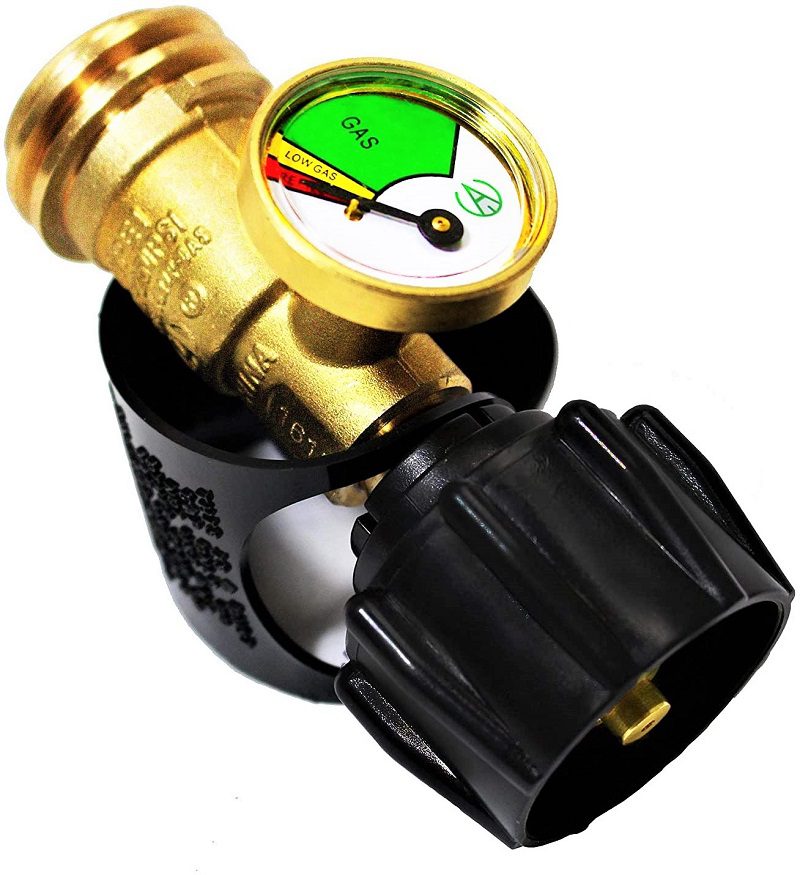
3. Make sure the propane tank is properly positioned.
Once you’re sure you have enough gas and the tank isn’t damaged, you can connect a propane tank to your gas grill. Different grill models offer different ways to secure the tank below the grill. Some grills have an open space below. Others have a built-in compartment for the tank.
Many grills have a hole near the bottom where you can position the tank. The grill’s manual instructions will show the correct way to position the tank when you connect a propane tank to your gas grill.
Be sure that you follow the instructions in the manual as you connect a propane tank to your gas grill. Proper positioning prevents the tank from falling over in the event of an accident. Installing the tank in any way other than the manufacturer’s recommendation might stress the regular connection and cause a leak.
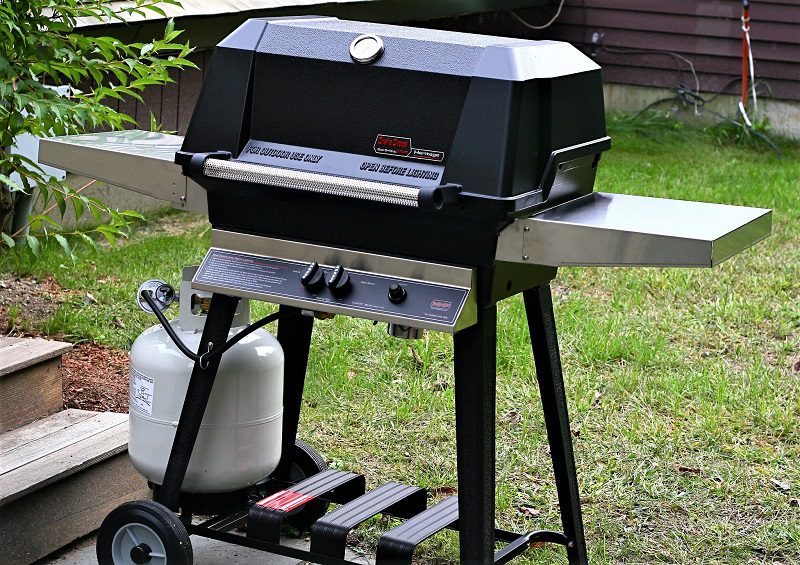
4. Connect the tank to the grill.
You need to familiarize yourself with a few key parts of the grill and the tank when you connect a propane tank to your gas grill. The easiest to identify is the valve. This sits right on top of the tank. Every gas grill also has a hose that connects the grill to the tank. A metal regulator and a black plastic connector are on the end of the hose.
The regulator controls the gas flow from your tank to the grill’s heating mechanism. Experts recommend that you change the regulator every 15 years after you regularly connect a propane tank to your gas grill. If you are using a new propane tank, but the grill isn’t working, you may need to replace the regulator.
To connect, take the hose and connect it to the tank. The black plastic connector at the end of the hose should fit snugly into the coupling mechanism of the tank. Turning the connector to the right will tighten it. Make sure the connection is as tight as possible.
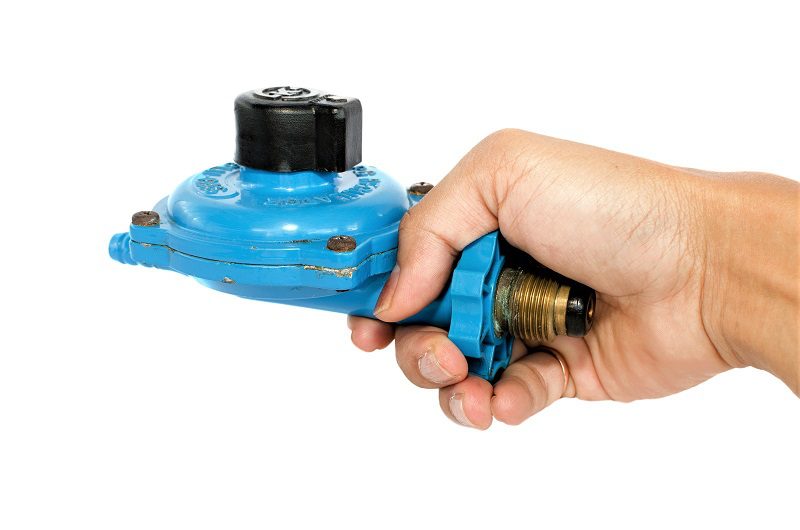
5. Perform a gas leak test before lighting the grill.
Once you connect a propane tank to your gas grill, perform a simple gas leak test. For this, you’ll need a spray bottle filled with a mixture of water and a bit of dishwashing soap.
Be sure the grill is completely off, then turn the valve on, allowing the gas to flow. Spray both the connector and the regulator with soap water. If bubbles appear, then there is a leak in the system.
Should this be the case, try tightening the connector again. If the bubbles persist, you probably need to replace the connector, the regulator, or the hose. You should perform the same test where the hose connects to the grill. That is usually right beneath the grilling area.
Once you have completed all the safety procedures, you can connect a propane tank to your gas grill again. Experts recommend that you press the igniter button before turning the knob on the grill to avoid gas accumulation. If your grill has no igniter button, use a long lighter. You’ll find a hole on the side of most grills where you can safely insert the lighter.
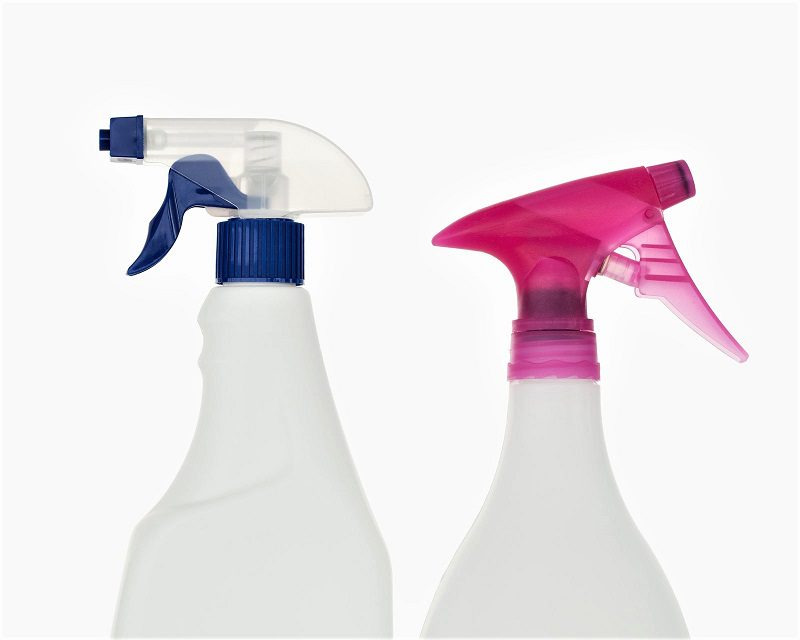
6. Be sure to close the propane tank valve when you’re done cooking.
Be sure you close the propane tank valve once you are done cooking. You don’t have to disconnect the tank from the grill, but the valve should be closed for safety reasons. Otherwise, trace amounts of gas can escape from the tank. The fumes create a serious fire hazard.
Apart from that, leaving the valve on can damage the grill. It can create a state known as bypass, which interferes with the flow of the gas when it’s in use. Your grill is likely to fall short of proper cooking temperatures when this happens.
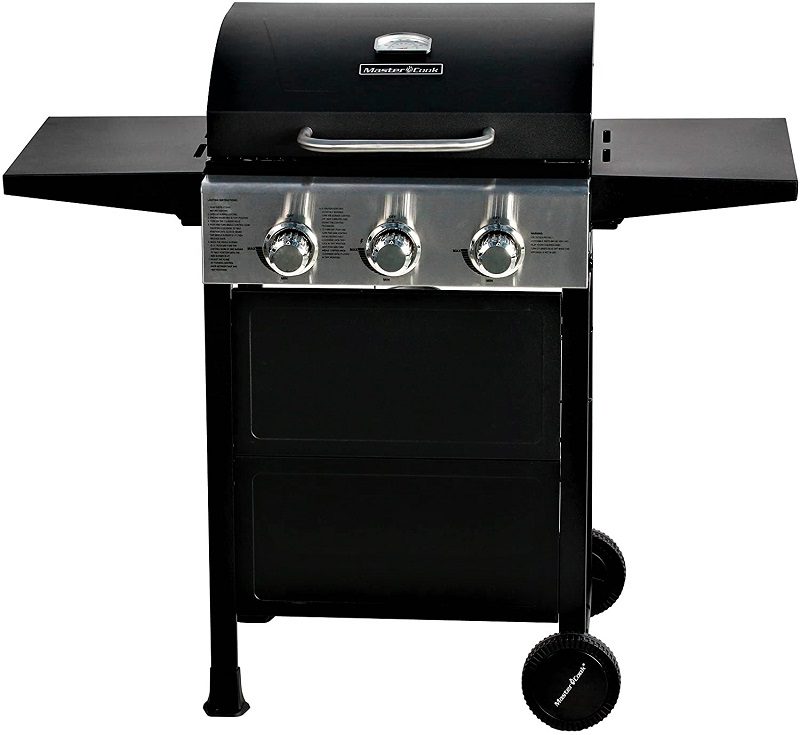
Make sure the gas grill is shut off and completely cooled before covering it after use. Remember, too, to use or store propane cylinders in an upright, vertical position. Be sure to store them outdoors away from sources of ignition, as well.
Troubleshooting Common Issues
Troubleshooting common issues can make connecting a propane tank to your gas grill smoother. Even with the right steps, you might run into a few hiccups. Here’s how to tackle the most common problems.
Gas Not Flowing After Connection
When you’ve successfully connect a propane tank to your gas grill but find that the gas isn’t flowing, the issue often lies with the regulator. The regulator is designed with a safety feature that can be inadvertently triggered, halting the gas flow as a precautionary measure. This can occur if the gas is turned on too quickly or if there’s a sudden change in gas flow.
Start by turning off the propane tank and grill to address this. This step is crucial for safety and to reset the system. Next, disconnect the propane tank from the grill.
It’s a good idea to wait a few minutes before you connect a propane tank to your gas grill again. This brief pause allows the regulator’s safety mechanism to reset. After waiting, reconnect the propane tank to your gas grill, ensuring all connections are secure and properly aligned.
Once you connect a propane tank to your gas grill, open the propane tank valve slowly to restore a gradual gas flow. This method helps prevent the regulator’s safety feature from being triggered again. This should resolve the issue if done correctly, allowing gas to flow freely to your grill.
If the problem persists despite these steps, the regulator may be faulty or damaged and need replacement. Handling gas and regulators should always be done with care and attention to safety protocols.
Difficulty Attaching the Tank
Experiencing difficulty when you connect a propane tank to your gas grill is often due to issues with aligning the tank’s connector properly. This common problem can usually be resolved with simple steps to ensure a secure and safe connection.
First, inspect the threads on the propane tank valve and the grill’s connector. These threads must be clean and free from any debris or damage. Dirt, grime, or even minor damages can prevent a proper seal, leading to difficulties connecting a propane tank to your gas grill. Use a clean cloth to wipe down the threads on the tank and the grill’s connector.
Next, carefully align the propane tank valve with the grill’s connector. It’s essential to ensure they are perfectly straight relative to each other before attempting to connect. Misalignment can result in cross-threading, which not only makes it harder to connect a propane tank to your gas grill but can also damage the threads, leading to gas leaks or the inability to secure the tank properly.
Once you’ve checked the cleanliness and alignment, gently turn the connector hand-tight. Applying too much force can damage the threads or the connector itself. Hand-tightening should be sufficient to establish a secure connection. However, ensure it’s snug enough to prevent gas leaks without over-tightening.
Following these steps, you can overcome difficulties and securely connect a propane tank to your gas grill, ensuring a safe and enjoyable grilling experience. Remember, if you continue to have trouble or suspect damage to the tank or grill’s connector, it’s best to seek professional advice or replacement parts to avoid safety hazards.
Hearing Gas Hissing After Connection
If you hear a gas hiss after you connect a propane tank to your gas grill, it’s essential to address this sign immediately as it likely indicates a gas leak. Gas leaks pose a serious safety risk, and identifying the source of the leak is a critical first step in resolving the issue.
To conduct a gas leak test, create a soapy water solution by mixing dish soap with water. Then, apply this solution to the connections between the propane tank and the gas grill. This includes the area where the tank’s valve meets the grill’s regulator and any other points where parts connect. The presence of soap bubbles forming when you connect a propane tank to your gas grill and turn on the gas indicates where gas is escaping.
Upon identifying a leak, the immediate next step is to turn off the gas at the propane tank to stop gas flow. Carefully tighten the connections where you’ve noticed the bubbles forming. It’s important to do this gently to avoid damaging the connectors, which could worsen the leak. After tightening, reapply the soapy water solution to check if the leak persists.
If, after attempting to tighten the connections, you continue to see bubbles or hear hissing when you connect a propane tank to your gas grill, the issue may be with faulty parts. This could be due to worn-out gaskets, cracked hoses, or a malfunctioning regulator. In such cases, it’s essential to replace the faulty components before using the grill again. Always choose replacement parts that are compatible with your grill’s make and model to ensure a safe and proper fit.
Addressing a gas leak promptly when you connect a propane tank to your gas grill is crucial for your safety and the safety of those around you. If you’re unsure about handling the situation or the leak seems severe, it’s advisable to seek assistance from a professional.
FAQ to Connect a Propane Tank to Your Gas Grill
How do I know when to replace my propane tank when I connect it to my gas grill?
When you connect a propane tank to your gas grill, monitoring the fuel level is crucial. A decrease in flame size or your grill not reaching the desired temperature can indicate it’s time to refill or replace your tank. Additionally, most tanks have an expiry date or a gauge to help monitor propane levels.
Can I connect a propane tank to my gas grill in any weather?
In most weather conditions, you can connect a propane tank to your gas grill. However, extreme cold can affect propane flow, and high winds can make lighting the grill more challenging. Always ensure the area is safe and sheltered if possible.
Is it safe to connect a propane tank to a gas grill alone?
Connecting a propane tank to your gas grill by yourself is safe if you follow the manufacturer’s instructions and safety guidelines closely. Ensure the grill and tank are off before connecting and perform a leak test afterward.
What should I do if I smell gas after I connect a propane tank to my gas grill?
If you smell gas after you connect a propane tank to your gas grill, immediately turn off the tank and grill. Check for leaks using the soapy water test. If you find a leak, tighten the connections. If the smell persists, disconnect the tank and do not use the grill until a professional has checked it.
How tight should the connection be when I connect a propane tank to my gas grill?
When you connect a propane tank to your gas grill, the connection should be secure and hand-tight. Avoid over-tightening, as this can damage the regulator or connectors. If you’re unsure, consult the grill’s manual or seek professional advice.
Can I use any size propane tank to connect to my gas grill?
The size of the propane tank you can connect to your gas grill depends on the grill’s design and capacity. Most grills are compatible with standard 20-pound tanks, but it’s best to refer to your grill’s manual for specific recommendations.
How often should I perform a leak test when I connect a propane tank to my gas grill?
Perform a leak test every time you connect a propane tank to your gas grill, as well as at the start of the grilling season and after changing the tank. Regular leak tests help ensure your grilling experience is safe and enjoyable.
What should I do with my old propane tank when I connect a new one to my gas grill?
When you connect a new propane tank to your gas grill and need to dispose of the old one, never throw it in the trash. Many areas have specific disposal or recycling programs for propane tanks. Check with your local waste management or recycling center for guidance.
Conclusion
Connecting a propane tank to your gas grill is a straightforward process that enhances your grilling experience. By following the safety guidelines and troubleshooting tips, you can ensure a secure and efficient connection every time you grill. Regular maintenance and safety checks are crucial to avoid common issues and enjoy the benefits of propane grilling.
Check out our guide for grilling on a timber patio for more safety tips!








